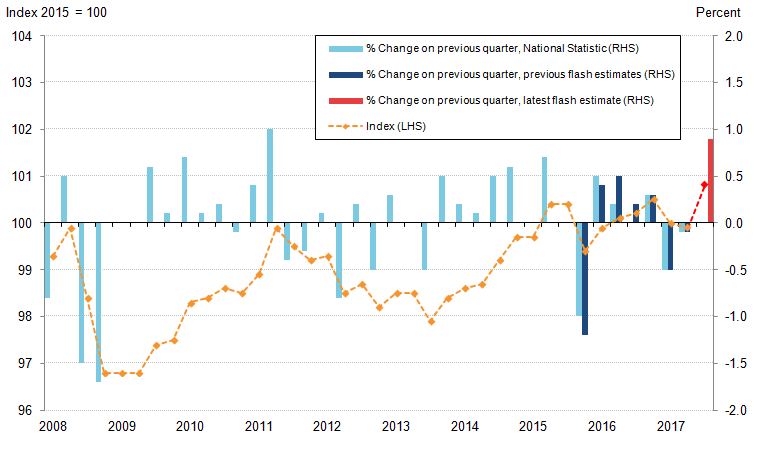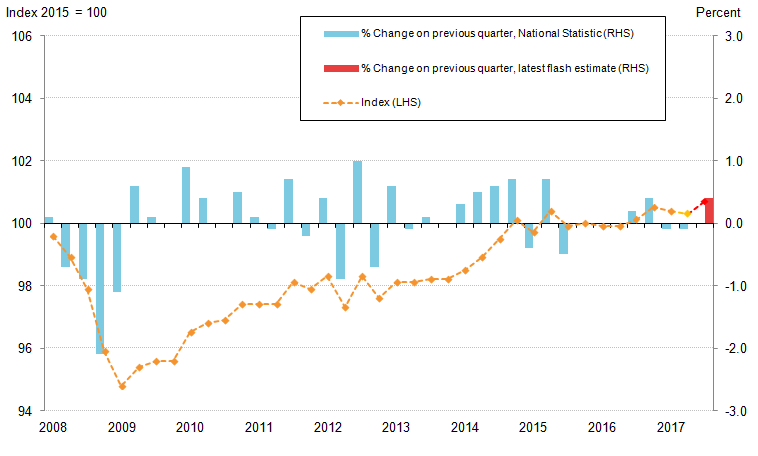1. UK productivity flash estimate: July to September 2017
Output per hour – Office for National Statistics’ (ONS’s) main measure of labour productivity – increased by 0.9% in Quarter 3 (July to Sept) 2017. This compares with a fall of 0.1% in Quarter 2 (Apr to June) 2017, as presented in Figure 1. Following two quarters of falling labour productivity, this is the fastest growth rate since 2011, resulting in a level of productivity slightly higher than its pre-downturn peak. Output per worker grew slower than output per hour, at a rate of 0.4% (see Figure 2).
Output per hour growth in Quarter 3 2017 was the result of a 0.4% increase in gross value added (GVA) (using the preliminary gross domestic product (GDP) estimate) accompanied by a 0.5% fall in total hours worked (using the latest Labour Force Survey data). This fall in total hours was driven primarily by a 0.5% fall in average hours per worker.
This flash estimate of UK productivity uses the first available information on output and labour input for the quarter. These data may be revised in subsequent months. As such, ONS releases the more detailed Productivity bulletin after the third estimate of GDP for the quarter is published, consistent with the quarterly national accounts.
Figure 1: Percentage change on previous quarter and index of output per hour
Seasonally adjusted, Quarter 1 (Jan to Mar) 2008 to Quarter 3 (July to Sept) 2017, UK

Source: Office for National Statistics
Download this image Figure 1: Percentage change on previous quarter and index of output per hour
.png (27.2 kB) .xls (20.0 kB)This is the first quarter of growth in output per hour since Quarter 4 (Oct to Dec) 2016 and is the highest rate of growth since Quarter 2 2011. UK productivity growth has been relatively weak over a longer period – in particular since the onset of the economic downturn in Quarter 1 2008 – as a result of the relative strength of the labour market as compared with GDP.
Figure 2: Percentage change on previous quarter and index of output per worker
Seasonally adjusted, Quarter 1 (Jan to Mar) 2008 to Quarter 3 (July to Sept) 2017, UK

Source: Office for National Statistics
Download this image Figure 2: Percentage change on previous quarter and index of output per worker
.png (23.0 kB) .xls (20.0 kB)Both employment – which captures the total number of people in work – and total hours – which captures both changes in employment and working patterns – fell in the course of the economic downturn, but total hours fell further reflecting falls in the average hours of those in employment. However, as GDP fell by a larger proportion in the economic downturn than either hours or employment and has grown slowly by historical standards during the recovery, productivity growth has been subdued since the downturn and has recovered more slowly than following previous downturns.
The increase in productivity in Quarter 3 2017 was a result of both a fall in total hours worked and growth in GVA. The most recent estimate of gross domestic product (GDP) indicated that the UK economy grew by 0.4% in Quarter 3 2017, which contrasts with a fall of 0.5% in total hours worked. Figure 3 shows these relative movements over the post-downturn period. It indicates that in Quarter 3 2017, the economy was around 9.3% larger than the pre-downturn level of output in Quarter 1 2008, while employment and total hours were around 8.0% and 7.7% above their pre-downturn levels respectively.
Figure 3: Index of gross value added (chained volume measure), employment level (aged 16 and over) and total hours worked (weekly)
Quarter 1 (Jan to Mar) 2008 to Quarter 3 (July to Sept) 2017, UK
Source: Office for National Statistics
Download this chart Figure 3: Index of gross value added (chained volume measure), employment level (aged 16 and over) and total hours worked (weekly)
Image .csv .xlsServices GVA grew by 0.4% in Quarter 3 2017, where the largest contribution came from finance and business services industries – which contributed 0.19 percentage points to whole economy GVA growth. Among individual industries, the largest contributions to whole economy GVA growth came from computer and programming activities (0.05 percentage points), wholesale and retail of motor vehicles (0.04 percentage points), and retail trade excluding motor vehicles (0.04 percentage points).
In production, manufacturing output grew by around 1%, following a decrease of 0.3% in the previous quarter. In addition, mining and quarrying output increased by 1.5%; electricity, gas, steam and air conditioning increased by 0.4%; and water supply, sewage, waste management and remediation activities increased by 0.4%.
Increases in production and services GVA were partially offset by construction output falling by 0.7%, following a fall of 0.5% in the previous quarter.
Industry and regional breakdowns of labour input and labour productivity will be published alongside the Labour productivity statistical bulletin on 5 January 2017.
Nôl i'r tabl cynnwys2. Background notes
Gross domestic product (GDP) data are from the Gross domestic product, preliminary estimate: (Quarter 3) July to September 2017 statistical bulletin, published on 25 October 2017.
Labour market data are from the Labour Market Statistics – November 2017 statistical bulletin, published on 15 November 2017.
Details of the policy governing the release of new data are available from the UK Statistics Authority.
Nôl i'r tabl cynnwys